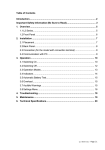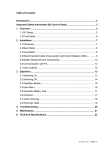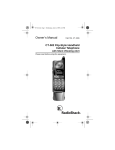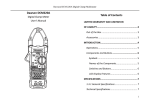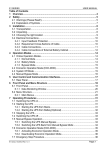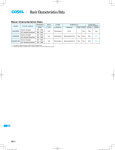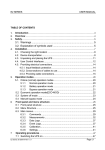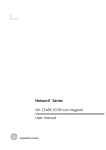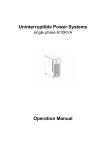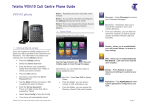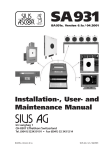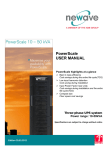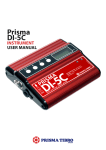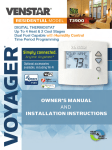Download User Manual - Elen
Transcript
Table of Contents Introduction .................................................................................................... 2 Important Safety Information (Be Sure to Read)............................................ 3 1. Overview ................................................................................................... 5 1.1 B2 Series .............................................................................................. 5 1.2 Front Panel ........................................................................................... 6 2. Installation ................................................................................................ 7 2.1 Placement ............................................................................................. 7 2.2 Back Panel ............................................................................................ 8 2.3 Connection ............................................................................................ 9 2.4 Recommended Cable Cross-section and Circuit Breakers (CBs) ............. 9 2.5 Battery Placement and Connections..................................................... 10 2.6 Communication with PC....................................................................... 12 2.7 Custom Contacts ................................................................................. 13 3. Operation ................................................................................................ 15 3.1 Switching On ....................................................................................... 15 3.2 Switching Off ....................................................................................... 17 3.3 Manual Bypass Circuit Breaker Usage ................................................. 18 3.4 Operation Principle .............................................................................. 19 3.5 Operation Modes ................................................................................. 20 3.6 User Menu .......................................................................................... 22 3.7 Automatic and Manual Battery Test ...................................................... 23 3.8 Overload ............................................................................................. 24 3.9 Audio Warnings ................................................................................... 24 4. Maintenance ............................................................................................ 25 5. Warnings ................................................................................................. 26 6. Troubleshooting...................................................................................... 28 7. Technical Specifications......................................................................... 29 B2 10-20kVA V1.0.1 – Page | 1 Introduction Thank you for choosing our Uninterruptible Power Supply product for protection of your electrical devices. The B2 Series Uninterruptible Power Supply (UPS) was manufactured using the latest technology. We recommend you to read this manual to learn many specifications and superior features of your new UPS. We do pay attention to the environmental impacts of this product. Example of some of our measures to protect environment are as follows: Product design is based on economical size and high efficiency approach. Quality and uninterruptible power is provided without distorting source voltage. Manufacturing is carried out in our ISO 14001:2004 Environment Management System certified factory. It is ensured that battery and metal wastes are disposed properly. To discover the entire range of our products and to receive up-to-date information, please visit our web site: ……………..……………………........................ Before you call us… If you require assistance for a failure or any related issues, call our Technical Support Center. For quick assistance, please have the following information available. Model Power (KVA) Serial Number Purchase Date Installation Date Mains Voltage/Frequency Battery Quantity x Ah Company B2 Series ……………………………… ……………………………… ……………………………… ……………………………… ……………………………… ……………………………… ……………………………… The B2 Series products are protected under a patent. Therefore, implementation of our proprietary technology by competitors is not permitted. Given the relevant standards and technology, device hardware configuration may be changed without notice. Technical specifications and dimension information are not binding unless formally confirmed by us. Page | 2 – B2 10-20kVA V1.0.1 Important Safety Information (Be Sure To Read) Life Safety Use UPS in an access-restricted room (EN 62040-1-2). The UPS has its own power source (batteries). Therefore, there may be live power at the output even if the mains voltage is disconnected. There is dangerous level of voltage in the UPS, and it must be opened by an authorized service personnel only. The UPS must be grounded in adherence to the rules. Do not expose batteries to extreme high temperatures to prevent fire risks. Do not attempt to open the battery. Chemical composition of the battery may be dangerous for your skin and eyes. Adhere to all regulations that govern disposal of waste batteries. Safe Handling Be careful while carrying loads. Do not carry heavy loads without help. Slide roller devices on smooth and even surfaces. Do not use slopes with angles over 10°. Adhere to following recommendations about load weights. An adult can carry loads up to 18 kg weight. Two adults can carry loads up to 32 kg weight. Three adults can carry loads up to 55 kg weight. Use pallet jack, forklift or similar devices for carrying loads over 55 kg weight. Keep packaging material for use in case the UPS has to be transported to an authorized service or to another location. UPS Safety The UPS must be safeguarded against voltage overload or short circuit voltages by means of a readily accessible circuit breaker. Do not operate the UPS at environment temperatures or relative humidity that exceeds the limits given in the manual. Never operate the UPS in liquid environments or in overly humid environments. Never allow water or foreign substances to penetrate in the UPS. Strictly do not clog ventilation grids of the UPS. Never expose the UPS to direct sunlight or a direct heat source. The UPS’ useful life is 10 years. B2 10-20kVA V1.0.1 – Page | 3 Special Safety Information UPS’ electrical connections must be provided as shown in the manual. Be sure to check the compatibility of the UPS power to mains voltage and to total load that will be supplied with UPS. UPS must be stored in a dry environment between -10°C and 45°C temperature prior to commissioning. UPS must be operated at least once a month continuously for 24 hours to charge the batteries. Because the battery life commences on the manufacture date, storage life is limited. UPS is designed to operate at height, operating environment temperature, relative humidity rate, and handling and storage conditions described in UPS manual. Special design and protection measures are essential for non-normal operating conditions. Such non-normal operating conditions include: - Harmful fume, dust, abrasive dust; - Humidity, vapor, bad weather, frost; - Explosive dust and gas mixtures; - Extreme temperature changes; - Poor ventilation; - Exposure to direct or radiated temperature from other sources; - Intensive electromagnetic fields and harmful radioactive levels; - Insects, pests, fungus, etc. Change and Recycling of Batteries Battery poses electric shock hazard and short circuit risks. Replace only with batteries of same type, capacity, number and dimensions. Battery replacement must be carried out by trained service personnel only. Remove metal accessories such as wristwatch, ring, etc. and wear rubber shoes and gloves to prevent accidents and personal injury. Use tools with isolated handles. Make sure that battery connections are not grounded by mistake. Do not leave tools or metal pieces on batteries. Batteries must be recycled. Return mutilated batteries to any recycling facility or to company where you initially purchased them along with packaging material of new batteries. UPS must be installed in strict adherence to following standards: HD 384.4.42 S1: Electrical Installation in Buildings, Chapter 4: Safety Protection Group 42: Protection Against Thermal Effects HD 384.4.482.S1: Electrical Installation in Buildings, Chapter 4: Safety Protection Group 48: Choosing Protective Measures Against External Effects – Section 482: Fire Protection in Places Bearing Special Risks or Dangers Page | 4 – B2 10-20kVA V1.0.1 1. Overview 1.1. B2 Series UPS Cabin Dimensions UPS Power (KW/KVA) Width x Height x Depth (mm) 7/10 10.5/15 14/20 255 x 870 x 730 Backup Time (min) (100% load/50% load) 0/0 2/5 3/7 4/11 5/13 7/22 Net Weight (kg) 10KVA 15KVA 20KVA 50 50 92 100 113 125 113 125 50 113 125 Figure 1.1 UPS Cabin Table 1.1 UPS Cabin Dimensions and Weights External Battery Cabin (optional) Dimensions Width x Height x Depth (mm) 255 x 710 x 640 Backup Time (min) (100% load/50% load) 0/0 5/13 7/22 9/25 11/34 13/39 25/70 41/110 Figure 1.2 External Battery Cabin Net Weight (kg) (UPS Cabin/External Battery Cabin) 10KVA 15KVA 20KVA 50/30 50/30 50/30 50/156 50/156 50/180 113/156 50/130 50/180 50/156 113/156 125/180 113/156 125/180 Table 1.2 External Battery Cabin Dimensions and Weights B2 10-20kVA V1.0.1 – Page | 5 1.2. Front Panel Figure 1.3 Front Panel No. LED On 1 mains Mains voltage(s) is (are) normal. Mains voltage(s) is (are) NOT within the tolerance limits. 2 by-pass In static bypass mode Not in static bypass mode 5 battery In battery mode Not in battery mode 7 normal In normal mode Not in normal mode 10 Overload UPS is loaded 0% to 100%. 11 Fault See: ‘3.8 Overload’ See: ‘3.9 Audio Warnings’ 3 Display No. BUTTON No fault warning Liquid Crystal Display (LCD) where operation information is shown. >3 seconds (Press and hold longer than 3 seconds) 4 On Off 6 Reversing the menu and the sub-menu order <3 seconds (Press less than 3 seconds) In normal mode: cancel execution/task In bypass mode: confirm execution/task Turning on/off warning sound Browsing through menu and sub-menu options Manual battery test start/stop Exit from sub-menu Cancel switching to bypass mode 8 9 Off Reversing the warning list order Entry to sub-menu Browsing through warning list Table 1.3 Front Panel Operation Page | 6 – B2 10-20kVA V1.0.1 2. Installation 2.1. Placement UPS Placement Do not install the UPS on an uneven ground or in outdoors. Note that ventilation holes on side covers must not be clogged. Do not install the UPS in places with liquid installation or places subject to fire risks. Do not install the UPS in places where it will be exposed to direct sunlight or affected of heat sources. Heed to minimum distance requirement between the UPS and nearby walls and/or devices. Do not install the UPS in places where it may be subject to vibration or impacts. Do not install the UPS in environments with excessive (too high or too low) humidity levels. Do not operate the UPS in dusty or filthy environments. Do not leave any materials on or around the UPS to facilitate and expedite maintenance and repair operations. Figure 2.1 UPS Placement The UPS may overheat if distance requirements are not met. Moreover, this may complicate maintenance and repair operations. The UPS must be installed in a room with restricted access (Authorized Personnel Only). External Battery Cabin Placement Heed to UPS placement instructions when placing the external battery cabin. Figure 2.2 External Battery Cabin Placement B2 10-20kVA V1.0.1 – Page | 7 2.2. Back Panel Figure 2.3 Back Panel No. Part Function 1 SNMP 2 RS232 3 Custom Contacts 4 Fans 5 6 7 8 9 10 11 Manual Bypass Circuit Breaker Cover Manual Bypass Circuit Breaker Metal cover is removed and adaptor is plugged in to this port if SNMP is used (See: ‘2.6 Communication with PC’). It ensures that the UPS can be monitored using a computer software (See: ‘2.6 Communication with PC’). It has ‘Gen-Set’ and ‘EPO’ user input pins; ‘Battery Mode’, ‘Battery Low’ and ‘Fault’ user output pins (See: ‘2.7 Custom Contacts’). They work depending on the loading percentages and cool the rectifier and the inverter units. It is used to prevent unauthorized persons’ intervention to normal operation. It ensures that loads are supplied mains voltage during a malfunction or maintenance. Terminal Cover It is used to prevent the contact with live contacts. Output Circuit Breaker Input Circuit Breaker Static Bypass Circuit Breaker Internal Battery Circuit Breaker It ensures overload and short-circuit protection. Also, it is used to switch on/off the output voltage. It ensures overload and short-circuit protection. Also, it is used to switch on/off the mains voltage(s). It ensures overload and short-circuit protection. Also, it is used to switch on/off the static bypass voltage. It ensures overload and short-circuit protection. Also, it is used to switch on/off the battery voltage. Table 2.1 Back Panel Operation Page | 8 – B2 10-20kVA V1.0.1 2.3. Connection Figure 2.4 Connections No. Connections + N - (+) pole Middle point (-) pole 1 BATTERY (External Battery Cabin) R S (R) T (R) N1 E1 2 INPUT PhaseR Phase-S (R) Phase-T (R) Neutral Earth U N2 E2 3 OUTPUT PhaseU Neutral Earth Table 2.2 Terminals Correct input connection, three-phase or single-phase, must be carried out at first installation. Phase transformation can be done by authorized service personnel only. 2.4. Recommended Cable Cross-section and Circuit Breakers (CBs) Input Output Internal Battery External Battery Static Bypass Manual Bypass Earth Cable Cross-section (mm²) 10KVA 15KVA 20KVA 4x4 4x4 4x6 2x6 2x6 2x10 3x6 3x6 3x6 3x6 3x6 3x6 2x6 2x6 2x10 2x6 2x6 2x10 1x6 1x6 1x10 Circuit Breaker (A) 10KVA C 3x25 C 2x40 C 3x40 C 3x40 C 1x80 C 1x80 15KVA C 3x25 C 2x40 C 3x40 C 3x40 C 1x80 C 1x80 20KVA C 3x32 C 2x50 C 3x63 C 3x63 C 1x100 C 1x100 Table 2.3 Cable Cross-section and Circuit Breakers B2 10-20kVA V1.0.1 – Page | 9 The cables and the CBs must be replaced with the cables and the CBs of same type and capacities only. 2.5. Battery Placement and Connections UPS Cabin 30 pieces of 7-9Ah (left side) (right side) Figure 2.5 30 pieces of 7-9Ah Battery Placement and Connections 20 pieces of 7-9Ah (left side) (right side) Figure 2.6 20 pieces of 7-9Ah Battery Placement and Connections Page | 10 – B2 10-20kVA V1.0.1 External Battery Cabin 30 pieces of 7-9Ah (left side) (right side) Figure 2.7 30 pieces of 7-9Ah Battery Placement and Connections 2x30 pieces of 7-9Ah (left side) (right side) Figure 2.8 2x30 pieces of 7-9Ah Battery Placement and Connections B2 10-20kVA V1.0.1 – Page | 11 30 pieces of 12Ah (left side) (right side) Figure 2.9 30 pieces of 12Ah Battery Placement and Connections 2.6. Communication with PC RS232 You can monitor the UPS over RS232 port using UPSilon2000 software that you will install on your computer (this is optional and therefore UPS software and RS232 cable must be ordered prior to use of this option). Using this software, you can monitor realtime UPS voltage and current information, battery information, malfunctioning warnings, etc. and save long term logs with graphics. In addition, software shuts down your computer and/or server safely in case of any electrical power outage. Figure 2.10 RS232 Communication SNMP (optional) SNMP (Simple Network Management Protocol) is an advanced communication protocol. Using SNMP, multiple UPSs can be synchronously monitored and managed from a single common center. SNMP can be connected to a computer or a network over an Page | 12 – B2 10-20kVA V1.0.1 ‘Ethernet’ communication port. An IP (Internet Protocol) number assigned to SNMP is used to connect to a UPS from anywhere on the network and monitor real time operation information, save long term logs, carry out testing, and turn on/off the UPS or the server. Figure 2.11 SNMP Communication 2.7. Custom Contacts When you use the UPS in environments where the UPS cannot be under consistent surveillance, you can have remote signals for power outage, audibly or visually. Using the outputs mentioned on a simple bell, siren or light circuit, the mains voltage and the battery capacity can be monitored. In this way, loads can be protected by being safely shut down. Also, user inputs ensure energy saving and reliable operation. Supply voltages of the user output circuits must NOT be higher than 50V. Figure 2.12 Custom Contacts B2 10-20kVA V1.0.1 – Page | 13 Battery Mode Audible or lighting device works during the UPS is in battery mode. Battery Low Audible or lighting device works during the battery capacity is less than 20%. Fault Audible or lighting device works during fault warnings. Gen-Set For energy saving, the UPS does not charge the batteries during gen-set is working. EPO (Emergency Power Off) It is used during a crisis (natural disaster or emergency) to prevent damage to the UPS and the load. Page | 14 – B2 10-20kVA V1.0.1 3. Operation 3.1. Switching On 1. Mains Start: a. Make sure that the connections are performed properly. Switch on the ‘INPUT’, the ‘STATIC BYPASS and then the ‘BATTERY’ CB (Figure 3.1). Press and hold button until a warning beep sound, meanwhile observe the ‘normal’ LED is on (Figure 3.2). Figure 3.1 Figure 3.2 b. If the mains voltage(s) is (are) within the limits, the ‘mains’ and the ‘by-pass’ LED will be on (Figure 3.3). Press button shortly and observe the ‘Mains Start’ warning (Figure 3.4). If the mains voltage(s) is (are) out of the limits, the ‘Fault’ LED will be on and a warning beep will be heard (See: ‘Cold Start’). Figure 3.3 Figure 3.4 c. Simultaneously, the ‘by-pass’ LED is off and the ‘normal’ LED is on. And, the UPS starts operating in normal mode (Figure 3.5). In this case, you can switch on the ‘OUTPUT’ CB and supply your loads from the UPS (Figure 3.6). If the ‘Fault’ LED and an audible warning is on, display the ’07WARNING’ menu and see ‘5. WARNINGS’. Figure 3.5 Figure 3.6 B2 10-20kVA V1.0.1 – Page | 15 2. Cold Start: The UPS has ‘Cold Start’ feature. It means that the UPS can be switched on battery without mains connection. a. Switch on the ‘BATTERY’ CB (Figure 3.7). Press and hold button until a warning beep sound, meanwhile observe the ‘normal’ LED is on (Figure 3.8). Figure 3.7 Figure 3.8 b. The ‘Fault’ LED is on since the mains voltages are not present and an audible warning is heard periodically. Press button shortly to turn off the audible warning (Figure 3.9), press shortly again and see the ‘Batt Start’ warning (Figure 3.10) and wait until the ‘battery’ and the ‘normal’ LED are on. If the ‘Fault’ LED and an audible warning is on, display the ’07WARNING’ menu and see ‘5. WARNINGS’. Figure 3.9 Figure 3.10 c. When the ‘battery’ and the ‘normal’ LED are on (Figure 3.11), you can switch on the ‘OUTPUT’ CB and supply your loads from the UPS (Figure 3.12). Figure 3.11 Page | 16 – B2 10-20kVA V1.0.1 Figure 3.12 3.2. Switching Off 1. If the UPS is in Normal Mode: Switch off your loads safely. Press button short. Press button short again to confirm bypass operation and observe the ‘by-pass’ and the ‘mains’ LED turn on (Figure 3.13, Figure 3.14). Press button to cancel the confirmation. Figure 3.13 Figure 3.14 The UPS must be switched to ‘Static Bypass Mode’ prior to fully switching off after normal mode. 2. If the UPS is in Static Bypass Mode: Press and hold button until the warning beep silences (Figure 3.15). Observe that the display is fully switched off. Switch off the ‘OUTPUT’, the ‘BATTERY’, the ‘STATIC BYPASS’ and the ‘INPUT’ CB in respective order (Figure 3.16). Figure 3.15 Figure 3.16 3. If the UPS is in ‘Cold Start’ Mode: Switch off your loads safely. Press and hold button until warning beep silences (Figure 3.17). Observe that the display is fully switched off. Switch off the ‘OUTPUT’ and the ‘BATTERY’ CB in respective order (Figure 3.18). Figure 3.17 Figure 3.18 B2 10-20kVA V1.0.1 – Page | 17 3.3. Manual Bypass Circuit Breaker Usage Do not switch on the ‘MANUAL BYPASS’ CB during the UPS is in normal mode. During maintenance or malfunction, please carry out the following instructions. 1. Remove the ‘MANUAL BYPASS’ CB cover (Figure 3.19). Figure 3.19 2. Switch on the ‘MANUAL BYPASS’ CB; switch off the ‘OUTPUT’, the ‘BATTERY’, the ‘STATIC BYPASS’ and the ‘INPUT’ CB (Figure 3.20). Figure 3.20 3. Press and hold until warning beep silences. Observe that the display is fully switched off and switch off the ‘INPUT’ CB (Figure 3.21). Fiqure 3.21 The ‘OUTPUT’, the ‘BATTERY’, the ‘STATIC BYPASS’ and the ‘INPUT’ CB must be surely switched off during the ‘MANUAL BYPASS’ CB is on. User will be responsible for any load or UPS malfunctions that may be experienced when switched to ‘Manual Bypass Mode’ without switching off the loads and the UPS first. Page | 18 – B2 10-20kVA V1.0.1 3.4. Operation Principle The B2 Series UPS has Online-Double Conversion and Three-Level Inverter technologies. The online-double conversion technology ensures a double energy conversion simultaneously and a mains-independent output voltage and frequency. It is the most reliable technology to protect critical loads. Also, the three-level inverter technology ensures a high efficiency operation. The B2 Series UPS has following operation principle. Figure 3.22 Operation Principle Mains It is a three-phase or a single-phase AC input voltage supply which provides input power. Input Filter It filters EMI (Electromagnetic Interference) and RFI (Radio Frequency Interference) effects of the mains. Rectifier It converts the three-phase or the single-phase AC input voltage to DC voltage. PFC (Power Factor Correction) It corrects input power factor, boosts the DC voltage and generates DC bus voltage. Inverter It converts the DC bus voltage to a single-phase AC voltage. Battery It stores electrical energy. The quantity of a battery group is 20 or 30 for 10KVA, 30 for 15KVA and 20KVA. Charger It converts the DC bus voltage to battery charge voltage and charges the battery group. Battery Transfer It transfers the battery voltage to input of the PFC unit. B2 10-20kVA V1.0.1 – Page | 19 Output It is a single-phase AC output voltage which provides output power. Inverter/Bypass Transfer It transfers the output voltage to the inverter voltage or the mains voltage continuously. Output Filter It filters EMI (Electromagnetic Interference) and RFI (Radio Frequency Interference) effects of the UPS. 3.5. Operation Modes Static Bypass Mode The mains voltage is transferred to output via the static bypass line and the inverter/bypass transfer unit. It is used to supply output from mains continuously in case of any malfunctions. Thus, malfunction does not affect output. Meanwhile, battery is not charged or discharged. Once the static bypass voltage is out of the limits, the output voltage is interrupted. Figure 3.23 Static Bypass Mode Normal Mode Rectifier, PFC and inverter operate. A mains-independent single-phase voltage is generated and transferred to output via the inverter/bypass transfer unit. Meanwhile, the charger charges the batteries as appropriate. It is the online-double conversion mode of the UPS. Figure 3.24 Normal Mode Page | 20 – B2 10-20kVA V1.0.1 Battery Mode Once the mains voltage(s) is (are) out of the limits, rectifier and charger doing not operate. The battery voltage is transferred to input of the PFC unit. PFC and inverter continue to operate from battery. The single-phase inverter voltage is transferred to output via the inverter/bypass transfer unit. Figure 3.25 Battery Mode Economical Mode (Eco-Mode) It is the highest efficiency operation mode. Rectifier, PFC and charger operate, inverter stands by. Normally, the UPS operates in static bypass mode. Once the static bypass voltage is out of the limits, the UPS switches to normal mode. If the mains voltage(s) is (are) out of the limits, the UPS switches to battery mode continuously. Figure 3.26 Economical Mode Manual Bypass Mode It is used to supply output from mains during maintenance or malfunction (See: ‘3.3 Manual Bypass Circuit Breaker Usage). Figure 3.27 Manual Bypass Mode B2 10-20kVA V1.0.1 – Page | 21 3.6. User Menu 01-MAINS (3-phase input) Instant information for mains voltage(s) is displayed. 02-BYPASS (1-phase input) Instant information for static bypass voltage is displayed. 03-OUTPUT Instant information for output voltage and loading ratio is displayed. 04-INVERTER Instant information for inverter voltage is displayed. 05-BATTERY Instant information for battery charge voltage and capacity is displayed. Note: The capacity percentage may NOT be exactly correct. Battery charge voltage is 270V or 405V for 10KVA, 405V for 15KVA and 20KVA. 06-DC-BUS Instant information for DC bus voltages is displayed. 07-WARNING The last 128 real time event log is displayed. 08-MISCELLANEOUS Hour, date, internal temperature and firmware information is displayed. Also, manual battery test can be executed. 01-HOUR Hour, minute and second information is displayed. Page | 22 – B2 10-20kVA V1.0.1 02-DATE Day, month and year information is displayed. 03-TEMPERATURE Instant information for internal temperature is displayed. 04-BATTERY TEST Manual battery test can be started and stopped. 05-PROGRAM NAME Rectifier and inverter firmware name is displayed. 01-RECTIFIER The rectifier firmware name is displayed. (3-phase input) 02-INVERTER The inverter firmware name is displayed. (1-phase input) 3.7. Automatic and Manual Battery Test The UPS operates in battery mode and carries out automatic battery test along 1 minute at 12:00pm in 15th day of every month. Also, the test can be carried out manually under the ’08-MISCELLANEOUS’ menu and the ’04-BATTERY TEST’ sub-menu. Both of tests can be started during the UPS is in normal mode. If the UPS is in static bypass mode or completely off during test day, the test is carried out in the next normal mode. It is checked that the batteries are damaged, or not during the test. If the battery test is positive, ‘Battery Test’ is displayed under the ’07-WARNING’ menu. Otherwise, ‘Batt Fault’ is displayed and an audible warning is heard. In this case, call the Technical Service. ‘Automatic Battery Test’ may also be carried out after long power outages. In this case, the ‘Batt Fault’ test result should be disregarded. An ‘Automatic Battery Test’ or a ‘Manual Battery Test’ on batteries charged for at least 10 hours should be regarded. The ‘Automatic Battery Test’ period and the test time cannot be changed. B2 10-20kVA V1.0.1 – Page | 23 3.8. Overload During overload; the UPS may run in normal operating conditions for below definedperiods. The UPS goes to static bypass mode when the below defined periods are exceeded. Loading Ratio %110%125 %125%150 >%150 Power (kVA) 15 20 16.511-12.5 22-25 18.75 18.7512.5-15 25-30 22.5 >15 >22.5 >30 10 Running Time 60 seconds 10 seconds 3 seconds Table 3.1 Overload Table The UPS has 150% overload capacity at most when running in static bypass mode. When the load ratio increases further, the UPS shuts down the output. 3.9. Audible Warnings Alarm 3 times consecutively at every 5 seconds 2 times consecutively at every 2 minutes CPU Error Phase Fault Emergcy Stop Manual Byp Pwm Fault OverCur Flt OverCur Byp OverCur Igbt OverCur Inv Warning Info OverCur Rec Output S/C Inv Fault Output Fault OverHeat Inv InvScr Fault OverHeat Rec Dc High Dc Low Battery High Batt Fault Battery Low Battery Test Freq Fault Battery Mode Mains Low Mains High UPS Shutdown Over Load Synchron Flt Charger Fail Fan Failure BypScr Fault Table 3.2 Audible Warnings Press on. Page | 24 – B2 10-20kVA V1.0.1 button to turn off the warning sound. Press again to turn 4. Maintenance The UPS should only be opened by authorized personnel. The UPS must be completely off during maintenance. Mains and battery connections must be disconnected and batteries must be moved away from the UPS. Follow the ‘Important Safety Information’ and ‘Installation’ instructions during the maintenance. The electronic boards and the fans should be cleaned regularly. The ventilation holes on the lid should be cleaned regularly. The UPS body should be cleaned with a soft and moist cloth. The sturdiness of cable connections, screws and sockets should be checked. The board supply voltages should be measured and checked. The components on the boards and the other hardware should be checked. The voltages of the batteries should be checked by measuring the voltages separately. The accuracy of the calibration and the adjustments should be checked. The dust, the heat and the temperature in the UPS room should be checked. The instructions in the ‘Important Safety Information and Installation’ should be complied. B2 10-20kVA V1.0.1 – Page | 25 5. Warnings Event Batt Fault 1 3 Batt Start Battery 2 High Battery 1 Low Battery 3 Mode Battery 3 Test Bypass 1-5 High Bypass 1-5 Low Bypass 2 Mode BypScr 5 Fault Charger 2 Fail 5 CPU Error 2 Dc High 2 Dc Low Emergcy 5 Stop 2 Fan Failure 3 Freq Fault 2 Inv Fault InvScr 2 Fault 3 Mains High 3 Mains Low 4 Mains Start Manual 1-2 Byp Normal 4 Mode Output 5 Fault 5 Output S/C 1Over Load Definition The batteries may be expired (See: ‘3.7 Automatic and Manual Battery Test’). The UPS is started on battery. The battery voltage is higher than the normal value. The battery capacity is low. The UPS runs on battery. Automatic or manual battery test is carried out. The static bypass voltage is higher than the upper limit. The static bypass voltage is less than the lower limit. The UPS is in static bypass mode. The UPS cannot transfer the static bypass voltage to output. Battery quantity or cable connection is not proper or the charger is faulty. A fault was occurred in microprocessor. The DC bus voltage is above upper limit. The DC bus voltage is below lower limit. The UPS output is shut down using the ‘EPO’ custom contact. The rectifier and the inverter fans are not working. Mains frequency is out of the limits. The inverter unit cannot generate the output voltage. Inverter voltage cannot be transferred to output. Mains voltage is above the upper limit. Mains voltage is below the lower limit. The UPS is started when mains voltage(s) is (are) within the limits. The ‘MANUAL BYPASS’ CB was switched on (optional). The UPS is in normal mode. A fault was occurred in the inverter unit. Short circuit at the loads, at the output, at the beam box or at the line. 2 The UPS is overloaded (See: ‘3.8 Overload’). OverCur 5 Byp Instant high current was drawn from output during bypass mode. Page | 26 – B2 10-20kVA V1.0.1 OverCur Flt OverCur 2 Igbt OverCur 2 Inv OverCur 2 Rec OverHeat 2 Inv OverHeat 2 Rec Phase 1 Fault 2 Pwm Fault 2 Stop Mode Synchron 2 Flt UPS 5 Shutdown 2 Instant high current was drawn from output at least 3 times during normal mode. Internal malfunction in the UPS or instant high current was drawn from output during normal mode. Instant high current was drawn from output during normal mode. Instant high current was drawn from mains during normal mode. Temperature of the inverter unit is higher than 75°C. Temperature of the rectifier unit is higher than 75°C. Mains phase squence is wrong. A fault was occured at switching signals. The UPS was switched to static bypass mode from normal mode. The output voltage and the mains voltage(s) are at different values. The UPS has shut down the system, since the battery capacity is at its lowest. Table 5.1 Warnings Table 1 4 : Operation mode remains unchanged. : Switches to normal mode. 2 5 : Switches to bypass mode. : Shuts down the output. 3 : Switches to battery mode. B2 10-20kVA V1.0.1 – Page | 27 6. Troubleshooting Make sure you go through the table below before contacting the Technical Service. Cable connections and CB checks must be performed by authorized personnel only. Definition of Failure The UPS is not being switched on and the leds are off. ‘Mains Low’ warning received. ‘Fault’ led is on and the UPS gives audible warning. ‘Overload’ led is on and the UPS gives audible warning. Time for running on battery is too low. Possible Cause Solution button is pressed shortly. Press sound. CBs are switched off. Switch on the CBs in appropriate order. button untill a warning beep Problem with cable Check input and battery cable connections. connections. Contact Technical Service. Mains voltage(s) is (are) Check the mains voltage(s) on the front out of the limits. panel. Problem with cable Check input cable connections. connections. Input CB failure. Check the input CB. Contact Technical Service. ‘Phase Fault’ warning Check mains phase squence. ‘Battery Low’ warning ‘Battery Mode’ warning See: ‘5. WARNINGS’ ‘Mains High’ warning ‘Batt Fault’ warning See: ‘3.7 Automatic and Manual Battery Test’ ‘OverHeat Rec’ warning Check the UPS load ratio and the environment temperature. Shut down the ‘OverHeat Inv’ warning UPS and wait for a while. ‘Emergcy Stop’ warning ‘OverCur Flt’ warning Switch off the UPS and switch on it again. ‘Output Fault’ warning Switch off the UPS. Make sure there is no ‘Output S/C’ warning short circuit on loads before switching the UPS back on. ‘Charger Fail’ warning Check the battery connections. Contact Technical Service. ‘Over Load’ warning Check the load ratio. Reduce the loads connected to the UPS output. Batteries were not fully recharged. Check back again once the batteries were recharged for at least 8 hours. Contact Technical Service. Table 6.1 Troubleshooting Table Page | 28 – B2 10-20kVA V1.0.1 7. Technical Specifications Power (KVA) INPUT Voltage Voltage tolerances Frequency Frequency tolerances Power factor THDi OUTPUT Voltage Voltage tolerances Frequency Frequency tolerances Power factor THDv Crest factor OVERLOAD CAPACITY ≤ 110% ≤ 130% ≤ 150% ≤ 160% EFFICIENCY Online Eco-mode GENERAL Technology Control Paralleling units Communication Remote monitoring Dry contacts Custom inputs Cold start Maintenance bypass ENVIRONMENT Operating temperature Relative humidity Maximum altitude Noise level UPS CABINET Dimensions (W x D x H) (mm) Weight (kg) Degree of protection Colour BATTERY Internal battery quantity Internal battery capacity (Ah) External battery cabinet socket STANDARDS Safety EMC UPS LIFETIME TECHNICAL SPECIFICATIONS B2 SERIES 15 20 380 / 400 / 415 Vac 3ph + N - 25%, +20% (without downgrading) 50 / 60 Hz ± 10% ≥ 0.99 < 8% 220 / 230 / 240 Vac 1ph + N ± 1% (static load), dynamic load in accordance with VFI-SS-11 50 / 60 Hz ± 0.1% (self-synchronize), ± 1% (mains-synchronize) 0,7 (0.8 optional) ≤ 1% (linear load), ≤ 5% (non-linear load) 3:1 30 min. 10 min. 1 min. 10 sec. up to 94% up to 98% Three level inverter, PFC Dual-DSP, SPWM Up to 6 units SNMP(Optional), RS232, RS485, MODEM, MODBUS SNMPView, Remote monitoring panel(optional) Programmable 3 dry contacts Generator, Remote EPO, Remote Start/Stop Standard Standard from 0 °C up to +40 °C (from 20 °C to 25 °C for maximum battery life) 0% - 85% (without condensation) ≤ 2000 m < 55 dB (A) 255 x 730 x 870 49 51 IP20 RAL7012 30 7-9 Standard EN 62040-1 EN 62040-2 10 years B2 10-20kVA V1.0.1 – Page | 29 ELEN reserve the right of changing information in this without report. AUTHORIZED TECHNICAL SERVICE Page | 30 – B2 10-20kVA V1.0.1






























